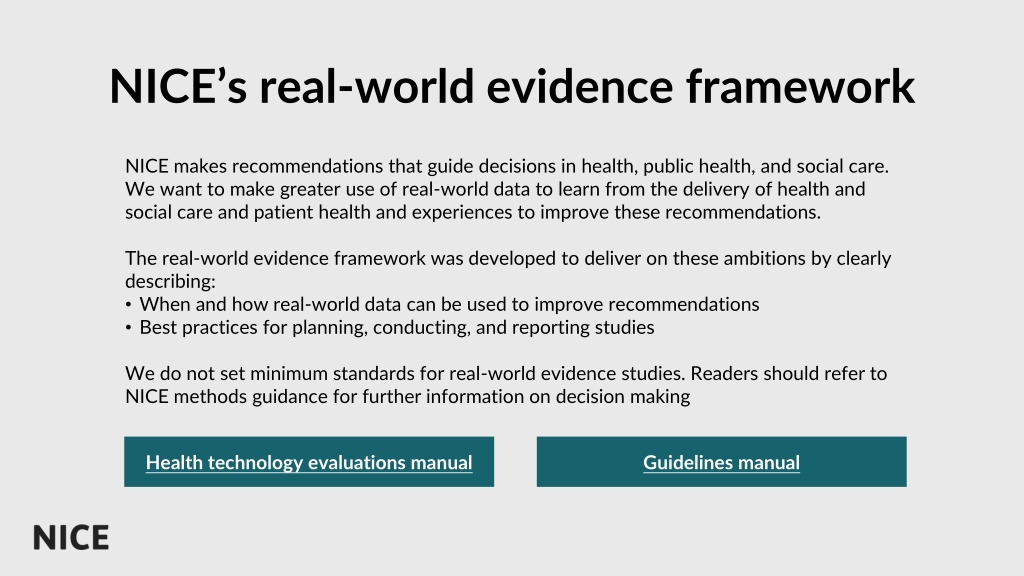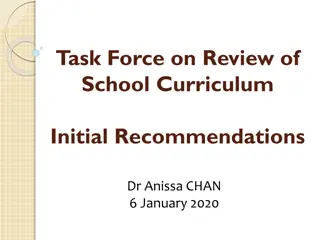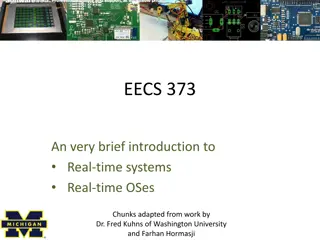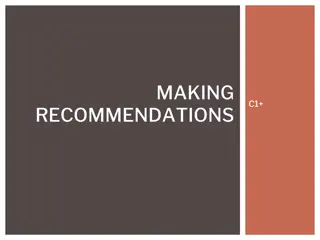Enhancing Recommendations with Real-World Data Framework
NICE's real-world evidence framework aims to utilize data from service evaluations, patient devices, and more to enhance recommendations in health and social care. Real-world evidence analysis can provide insights into patient experiences, technology impacts, and care outcomes, improving decision-making processes. The framework emphasizes transparency, data suitability, and method integrity in evidence generation for effective decision making in healthcare.
Download Presentation

Please find below an Image/Link to download the presentation.
The content on the website is provided AS IS for your information and personal use only. It may not be sold, licensed, or shared on other websites without obtaining consent from the author. Download presentation by click this link. If you encounter any issues during the download, it is possible that the publisher has removed the file from their server.
E N D
Presentation Transcript
NICEs real-world evidence framework NICE makes recommendations that guide decisions in health, public health, and social care. We want to make greater use of real-world data to learn from the delivery of health and social care and patient health and experiences to improve these recommendations. The real-world evidence framework was developed to deliver on these ambitions by clearly describing: When and how real-world data can be used to improve recommendations Best practices for planning, conducting, and reporting studies We do not set minimum standards for real-world evidence studies. Readers should refer to NICE methods guidance for further information on decision making Health technology evaluations manual Guidelines manual 1
What is real-world data? Data from service evaluations or audits or generated from patient devices Real-world data is data relating to patient health or experience or care delivery collected outside of clinical trials Routinely collected data: patient health records, health service administrative records Data collected for specific research projects: patient registries, cohort studies, surveys 2
Real-world evidence leads to Analysis of real-world data Real-world evidence can improve our understanding of health and social care delivery, patient health and experiences, and the impacts of health technologies, including devices and digital health technologies, in routine settings. Effects of technologies on patient and system outcomes Patient or user experiences Impact of tests on decisions about care Populate and validate economic models Characterise disease, care delivery, and outcomes Impact of technologies on the delivery of care 3
Principles of evidence generation 2 2 research question. 3 3 1 1 Transparency Data suitability Methods Generate evidence in a transparent way and with integrity from study planning through to study conduct and reporting. Ensure data is trustworthy, relevant and of sufficient quality to answer the Use analytical methods that minimise the risk of bias and characterise uncertainty. 4
Population Planning and conducting studies Who is the intended population for the technology? Studies should be planned up front as far as possible including when using already collected data Intervention Plan studies in advance and share protocols where possible. What is the technology and how is it used? Clearly define the research question use the PICO framework where applicable Where in the care pathway will it be used? Choose or collect data that is trustworthy and fit-for-purpose. Comparator Follow national laws, regulations, and codes of practice for data collection and use in the UK consult the Health Research Authority Only needed for comparative study designs The ideal comparator is the current standard of care in the UK Use appropriate study design and analytical methods Outcomes Use proportionate quality assurance What are the patient and system outcomes that matter? How are they measured and when? 5
Key content for reports: Transparent reporting Describe the data and methods enables reviewers to understand what was done Demonstrate data provenance and fitness- for-purpose Fully describe data curation, study design, and analytical methods builds confidence in the results allows independent researchers to reproduce the results Report results completely Results of all analyses, whether planned or unplanned Fully describe patient exclusions, participation rates, and loss to follow-up and present all important patient characteristics by intervention or subgroup 6
Assessing data suitability Data provenance Data provenance Fitness for purpose Fitness for purpose What was the purpose of data collection? How much data is missing on key study variables (see PICO)? Why is data missing? How accurately is data recorded? Quality What data was collected, in what settings, how and by whom? How was accuracy assessed? Does the data source contain all relevant study variables? Data documentation and quality management Relevance Is the population similar to the intended population for the technology? Data governance arrangements Are the care settings relevant to patient care in the NHS Are the sample size and follow-up sufficient to generate reliable results? 7
Real-world evidence studies of comparative effects Real-world evidence can be used in the absence of trial evidence or to complement it to answer a broader range of questions about the effects of interventions in routine settings. Here we present best-practices for cohort studies (including trials using real-world data to form external control). Other study designs including quasi-experimental designs might be most appropriate for some interventions. Design studies to emulate the preferred randomised controlled trial use a target trial approach Identify potential confounders and address these considering observed and unobserved confounding Consider the impact of bias from informative censoring, missing data, and measurement error address appropriately where required Use sensitivity and bias analysis to assess the robustness of study findings 8

























